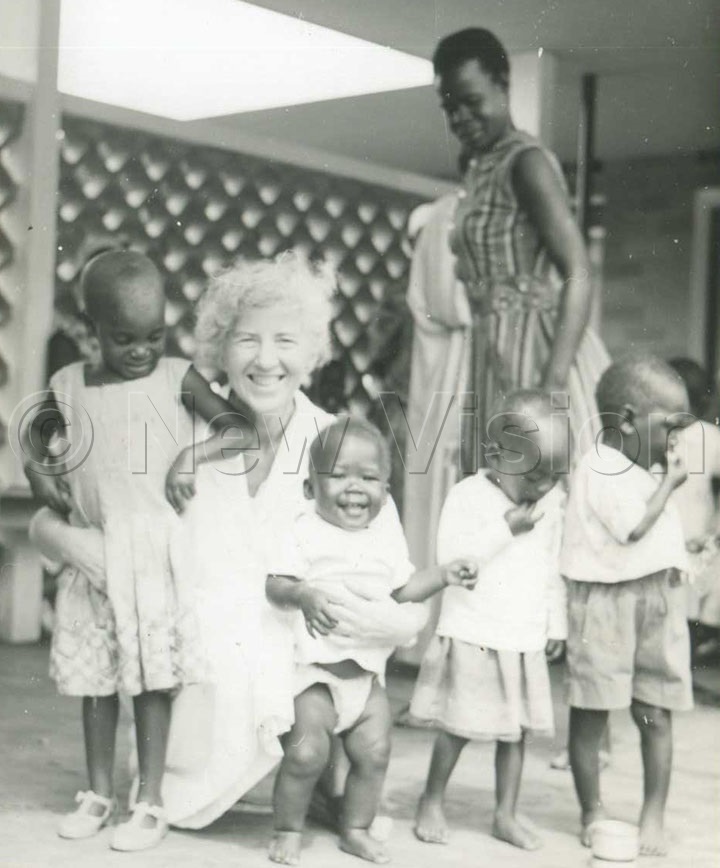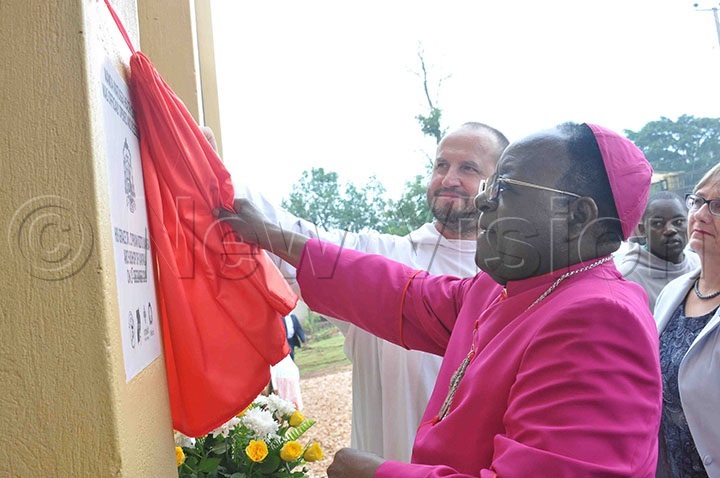Uganda poised to produce another saint
Błeńska arrived in Uganda in 1950 to settle at Buluba, about 16 km by road, north-west of Mayuge district headquarters. There, she volunteered to serve the sick, especially lepers.
RELIGION
A doctor who spent over 40 years treating lepers in Uganda is set for beatification, a stage of canonization in the Catholic Church, six years after her death. Wanda Błeńska died in 2014 at the age of 103.
She was a secular missionary, who established the Wanda Błeńska Training Centre - a medical facility near Lake Victoria.
Błeńska arrived in Uganda in 1950 to settle at Buluba, about 16 km by road, north-west of Mayuge district headquarters. There, she volunteered to serve the sick, especially lepers. Thanks to her work and dedication, the Franciscan Sisters' institution gained worldwide fame. The treatment and training centre she established, came to be called St. Francis Hospital, Buluba, now an internationally respected treatment centre. It comprises a 100-bed hospital, children's ward, diagnostic facilities, leper homes and a church.
Mother of lepers
Błeńska was known for helping her patients with leprosy without wearing gloves during treatment. She said gloves frighten and discourage them. To Błeńska caring for her patients went beyond the physical. Their dignity and emotions were just as important.
And, thanks to her, thousands of people were cured. No wonder, she got herself a title; ‘mother of lepers'. She contributed to the development of a network of branches of the centres in Uganda. Thanks to these stations, treatment and sanitary education have become available to the sick. Blenska is also a co-creator of modern methods of treating leprosy.
On her 100th birthday in 2011, the retired doctor said she was grateful to God that she could be there and help people.
"It was years of hard but happy work. During this time I have experienced a lot of cordiality and kindness, a lot of good especially from the people I met in Africa," she said.

Another of her initiatives was the "adoption of the heart". In many of the lectures she gave, she repeatedly encouraged donating a small amount once a month to pay for education and boarding school for one of the leper children. With such money mobilized, she established the Wanda Blenska Training Centre, a medical facility near Lake Victoria.
Interestingly, in 1955, Blenska became the first woman to conquer Mount Rwenzori. She also received an honorary citizenship of Uganda. Her numerous distinctions include the Order of St Silvester from Pope John Paul II.
She also received an honorary doctorate of the Medical Academy in Poznań and, in 2007, she was the first laureate of the Ryszard Kapuściński Prize awarded by the Marshal of the Wielkopolska Region. After her death, she was honoured with the title; Poznań's female citizen of the century, in December 2018.
Her life and times
Dr Błeńska was born in Poznań on October 30, 1911. She became a doctor in 1934 and practiced medicine in Poland till the Second World War of 1936. The war disrupted her work as she left to join the Polish resistance movement, known as the Home Army, to fight against the Nazi-German occupation of Poland.
She rose to become a second lieutenant and commander of the women's branch circuit of the Home Army in Toruń.
After the war, she was appointed the superintendent of the municipal hospital in Toruń. From 1945 to 1946 she worked at the Medical University of Gdańsk. In 1946, she started studying tropical medicine in Hanover inorder to serve in Africa. In 1948, she did postgraduate studies at the Institute of Tropical Medicine and Hygiene at the University of Liverpool.
In 1951, she moved to Uganda and served as chief physician at a leprosy treatment centre in Buluba, Mayuge district. Under her care, the facility expanded into a 100-bed hospital of international repute as a leprosy treatment centre. It is the only General Hospital in the district but serves many patients from other parts of the country due to its good quality of services.
The hospital had been founded by the Franciscan Missionary Sisters for Africa in 1934 as a specialized facility in the treatment of leprosy, which was endemic in the area. The sisters eventually handed over the hospital to the Catholic Diocese of Jinja, who kept it under the management and administration of the congregation of the Little Sisters of St. Francis. Later, the hospital added tuberculosis to the diseases it specializes in.
Today, Buluba Hospital attends to all general medical problems but maintains a prosthetic unit (initiated by Błeńska), one of the few in the country. A prosthesis or prosthetic implant is an artificial device that replaces a missing body part, which may be lost through trauma, disease, or a condition present at birth.

In 1983, she passed the leadership of the centre to a successor but continued to work there for the next 11 years before retiring to Poland. She died in 2014 at the age of 103.
Another centre
Recently, Franciscan missionaries based at Munyonyo Martyrs Shrine and Matugga Parish, with help of Polish government, built a sh2.5 health centre at Mabanda-Matugga in Wakiso district named Wanda Health Centre to help the community.
The function presided over by Archbishop of Kampala, Dr. Cyprian Kizito Lwanga, and graced by then ambassador of the polish embassy to Nairobi, Eva Zaleska who led a delegation from Poland. Also present was Wakiso district chairman, Matia Lwanga Bwanika, Nansana Mayor, Regina Nakazzi Bakitte, Wakiso district Chief Administrative Officer Luke Lokuda and area MP, Robert Ssebunnya.
Lwanga called on all health officials to emulate Dr Błeńska to love their patients and not be afraid of them.
"A doctor must be a friend of the patient. The most effective cure is love, as emulated by Dr Błeńsk," Lwanga said.
Ambassador Bazański hailed Bleska's work in Uganda, which sparked off a working relationship with the government and contributed to changes in the provision of health care for lepers. Not only did this create a network of leprosy treatment stations throughout the country, but it also availed leprosy prophylaxis for thousands of people, effectively changing the national attitude toward this disease.
In 1994, one of the buildings of the St. Francis hospital complex in Buluba was named The Wanda Blenska Training Centre in her honour.
The Wanda Błeńska Health Centre received a new ambulance purchased as part of a Polish Aid project.
Fr Wojtek Ulman, a.k.a Male, the parish priest of Uganda Martyrs Basilica Munyonyo, praised God for the process of canonization of Błeńska.
Beatification
Beatification is a step towards being declared a saint of the Roman Catholic Church. According to the Roman Catholic Church, canonization is the official admission that the dead person is actually a saint.
In February 2020, the Roman Catholic Archdiocese of Poznań initiated the first steps for her canonization cause.
The head of the Polish Episcopate Archbishop Gądecki described her as a person willing to sacrifice.
"What she saw in the lepers was not just the disease. She saw the entire human being, along with its fears and hopes, who deserved, apart from professional care, respect and tenderness. She undertook to redeem the sense of dignity and overcome the fear of leprosy. She was named the Mother to Lepers," Archbishop Gądecki wrote in 2019.
In the Catholic Church, when a dead person is taken through the process of canonization and proved to be a saint, Catholics are then encouraged to pray to God through their intercession. The saint is added to the general calendar of the Church or a region of the world, or a particular community they are relevant to. Churches, communities, people and causes can also be named after them. The saint can also be publicly invoked and mentioned officially in the liturgy of the Church, including in the Litany of the Saints.
So far Uganda has 22 people who are recognized as saints and they are the Uganda Martyrs, who were executed between 31 January 1885 and 27 January 1887. Uganda celebrates Uganda Martyrs every June 3.
To become a saint, the person must have exhibited virtue in his or her life. They must have been acclaimed by many as good people, worth of time and expenditure to pursue canonization for. When such people die, the Church recognizes them as the faithful departed.
The process goes through five stages. The first begins with the promoters documenting the life and virtues of a dead person and approaching their parish priest to begin the process. The Parish priest forwards the petition to the bishop, who constitutes a committee to study the petition. If convincing, the Bishop applies to the Vatican for the initialization of a Cause for Beatification and Canonization. The Vatican Congregation for the Causes of Saints then investigates the facts on the ground and, if convinced, permits the initiating Bishop to start. At that level, the person gets a title; Servant of God
This is the level at which Dr Błeńska is. Others are Fr. Simeon Lourdel (Mapeera) and Bro. Amans Delmas.
Rome appoints a relator to superintend the cause through the rest of the process. The Relator verifies the documents and presents them to the theological commission and members of the congregation for a vote. If recommended, the Pope pronounces a Decree of ‘Heroic in Virtue' which makes the Servant of God become the Venerable.
The Vatican then calls for miracles received by praying through the Venerable. Ugandans at this stage are Msgr. Aloysius Ngobya and Sister Amadeo Byabari of Masaka Diocese.
Every miracle must be verified by the scientific commission using accepted scientific criteria. Once the miracle is approved, the Servant of God is then beatified and declared the Blessed. The Blessed Daudi Okelo and Jildo Irwa of Gulu Archdiocese were beatified by Pope John Paul II on October 20th, 2002.
After beatification, the Church looks for a second miracle before proceeding to canonization. By the Rite of Canonization ends with the pope declaring the blessed a saint. The Uganda Martyrs were canonized on October 18, 1969, by Pope Paul VI.